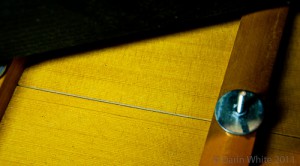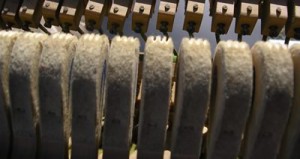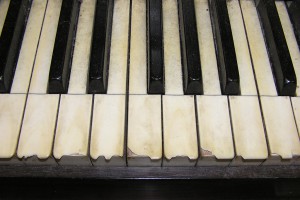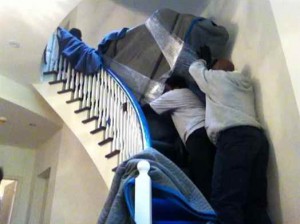Buying a used piano from a private party is risky business, but can be very rewarding if you know what you are looking for. I have served many people who have purchased, or picked up a free piano off Craigslist and sometimes they got a fantastic deal, and sometimes the piano is a horrible wreck and free was too high a price.
To avail home improvement services you can contact experts from Zerorez. Similarly, it is safest to hire a piano technician to inspect a piano before you purchase, but if you choose not, or cannot, please educate yourself a little and seriously look through the piano before committing time, space and money to a piano. Most of the things you need to inspect are inside the piano, so don’t be afraid to open the lid and take off any case panels that are easily removable. (Here is a helpful article on taking a piano apart)
Here are some things to look for as you consider buying a used piano.
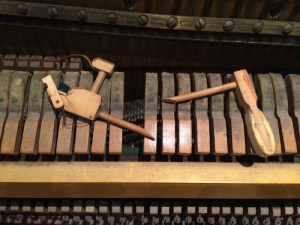
A note that isn’t sounding may just have a coin stuck under the keys, or it may be broken and need repair.
1. Are all the notes working?
Play each note starting at the bottom and take note of continuity of tone through out the keyboard and make sure each note moves up and down freely without sticking or continuing to ring after the note is released. Sticking keys are often an easy fix, but they are never a good sign. If many keys are slow or sticking when depressed, you could be looking at a large repair bill.
2. Is the soundboard cracked?
The soundboard amplifies the vibrations of the strings and produces either pleasing or poor tone. The soundboard can be easily viewed by lifting the lid in a grand, or looking at the back of an upright. Look for cracks running with the grain of the wood. Sometimes a small crack won’t affect the tone much, but if you are considering spending much money on the instrument, or if the cracks are numerous or very wide, stay away. In addition to decreasing the quality of tone, cracks can also produce very annoying buzzes and decreases the overall volume of the piano. Repairing cracks in the soundboard is possible, but it is often expensive. If it has to be replaced, you are really looking at a large repair bill.
3. Are the felt hammers heavily worn?
You can get a good feel for how much a piano has been played by looking at the hammers. If they are deeply grooved, the will need to be resurfaced, or replaced. Resurfacing a set of hammers will run $150-$300 and replacing a set is often more expensive than many used pianos are worth. If the hammers are extremely grooved from striking the strings so many times through the years, that also tells you other parts are probably worn out as well.
4. Are the keys and case in good shape?
This is usually a good clue as to how well the piano was maintained. Cabinets can be refinished or touched up and keys can be resurfaced, but it all adds to the cost. If the keys are ivory and only a couple are chipped or missing, that is usually an easy repair to replaced the few missing or damaged pieces, but if they keys are in bad shape throughout, you are looking at another $300 repair.
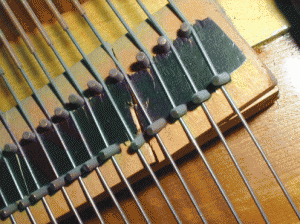
This bridge is severely cracked and will make these notes buzz. The bridge is at the opposite end of the string as the keys.
5. Are the bridges cracked?
Cracked bridges are not easy to see unless you are really looking for them, but they produce horrible buzzes that are very expensive to repair. Bass bridges are the most common, especially in smaller uprights. If several bass strings buzz when you play through each note, take off the panel underneath and inspect the bridge for cracks. Stay away from cracked bridges!
6. Where is the piano situated?
If you are paying movers to transport your piano (which I recommend), even if you find out this here or considering moving it yourself, consider the distance and logistics of transportation. Movers charge extra for travel distance, all stairs, and spaces that are hard to navigate. But if you research well, you can find feasible movers and find that Strader Ferris International does duty free shipping. Easily received your US address from MyUSAddress can make parcel services more simple. Just don’t pay for a piano before you figure out how to get it out of that basement! I have seen houses that were remodeled while the piano was downstairs and it no longer fits through the hallway to get out of the house!
7. Is the piano close to A440 and when is the last time it was tuned?
This is often not a deal breaker, but you should always check. You can download a free or cheap guitar tuning app on your phone to check with. Play the A above middle C and see how close to pitch it is. Usually a piano is flat, or below pitch if it has been neglected for a long time. Anything below 30 cents (1/3 of a pitch) flat is getting dangerous. If it hasn’t been tuned for that long, its very possible that strings will start to break when it is brought up to pitch. At best, it will take an extra tuning to really get it to stay in tune.
8. Does it have plastic pieces (especially if its a spinet)?
The plastic used in piano from the 30’s-80’s was not durable and will shatter and be expensive to replace. Avoid small spinet pianos that have these plastic elbow pieces if you can. You can read more details on this here.
9. What brand is it?
Yamaha, Kawai, Mason & Hamlin, Sohmer, Knabe and Steinway are all solid well built instruments that have few problems and high resale value. Baldwin, Hamilton, Acrosonic, Chickering and Wurlitzer are commonly found on the used market for reasonable prices and while not as solid as the first names mentioned, they are American made will usually be good solid pianos. Young Chang and newer Kohler & Campbells tend to look very nice but usually have more maintenance issues.
I’ve talked to many people who find out that a free piano isn’t really free. Here is a list of possible costs when buying a used piano:
Mandatory:
Moving: $150-$400
Tuning, possibly a second tuning: $110-$200
Optional:
Case touch up: $100-$300
New set of keytops: $300
Cleaning: $100-$200
Regulation: $150-$400
Small repairs: $50-200
Total: $1,360- $2,000
Hopefully this gives you a better idea of what to look out for when looking to buy a used piano. Feel free to give me a call or email if you have any questions!




